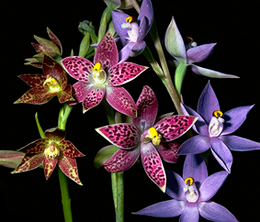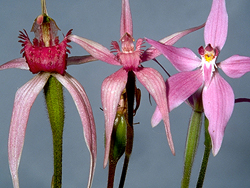
 |
Natural hybridisation is a significant evolutionary process that occurs in some groups of plants and can result in progeny that are able to exploit new habitats and possibly lead to the formation of new species. In general the incidence of natural hybridisation in Australian orchids is low, but it occurs more often in certain groups and involves both terrestrial and epiphytic species. The discovery of a natural hybrid generally arouses interest, although some observers take it to the extreme and display more interest in the hybrid than in the parent species involved.
Interspecific Hybrids: The majority of hybrids occur between species within a genus. The parent species can share similarities and appear to be related (e.g. hybrids between Jonesiopsis nobilis and J. footeana; also J. caesarea and J. polychroma, Caladenia flava and C. latifolia) or to be quite distinct morphologically and distantly related at best (e.g. hybrids between Jonesiopsis sigmoidea and J. microchila; also J. multiclavia and J. horistes, Diuris punctata and D. behrii). The attached image shows a natural hybrid (centre) between Thelymitra fuscolutea (LHS) and T. macrophylla from southwest of Albany, Western Australia, both from very different groups within Thelymitra.
Similar but Different: Hybrid progeny of similar general appearance but of different genetic makeup can result from the natural crossing of related taxa. For example Diuris ×palachila is a South Australian hybrid between D. behrii and D. pardina. A distinct unnamed hybrid with a similar general appearance occurs in Victoria between D. chryseopsis and D. pardina. Similarly ×Taurodium toveyanum is a Victorian intergeneric hybrid between Diplodium striatum and Taurantha concinna. In Tasmania a natural hybrid between D. alatum and T. concinna has a similar appearance but is genetically different.
Intergeneric Hybrids: The majority of Australian orchid genera do not participate in natural hybridisation at all. However sporadic hybrids occur between certain species in different genera when they are growing sympatrically. Frequently these genera are closely related and the appearance of hybrids may be a reflection of the artificiality of classification systems rather than the crossing of established genetic boundaries. For example in some parts of Western Australia natural hybrids occur with some frequency between sympatric species of Arachnorchis and Jonesiopsis; also Vappodes and Durabaculum on Cape York Peninsula. These genera are considered by some botanists to be very closely related, but by contrast hybrids are very rare between genera that are very distinct, including Glossodia and Pheladenia, Cyanicula and Elythranthera, Tetrabaculum and Thelychiton, Thelychiton and Tropilis. The attached image shows a natural intergeneric hybrid (centre) between Arachnorchis gardneri (LHS) and Caladenia latifolia from near Augusta in Western Australia.
 |
Factors Influencing Natural Hybridisation: Natural hybrids between native orchid species usually only occur when the parents grow in close proximity and their flowering times overlap. Both species must share a pollinating agent, even if only for the brief period that pollen transfer occurs. The more abundant the parent species are at any location the greater the chance of natural hybridisation occurring. Events triggering mass flowering, such as summer bushfires or good seasonal rains also increase the chances of natural hybridisation.
Many orchid species have specific pollinating agents but sometimes environmental factors cause a breakdown of barriers that isolate them. Natural hybrids are more frequent in disturbed sites (cleared habitats, road verges, etc) than in natural environments, possibly due to the breakdown of isolating mechanisms or changes in foraging behaviour by pollinators.
Absence of Natural Hybrids: Many species do not hybridise despite growing sympatrically and with overlapping flowering times. Often this can be due to strict pollinator isolation, as occurs in species pollinated by sexual deceit, but other factors can have an influence. For example Rhinerrhizopsis moorei and Pomatocalpa macphersonii share the same pollinator, a native bee, in the Iron Range area of northern Queensland, but are isolated by the placement of the pollinarium on the insect. When visting R. moorei the pollinarium is deposited on the head of the bee, whereas that of P. macphersonii becomes attached to the thorax. Similarly, but via a different route, all 5 native species of Cryptostylis are pollinated by the same species of ichneumon wasp, Lissopimpla excelsa, but natural hybrids are unknown, despite it not being uncommon to find two or more species flowering sympatrically in eastern Australia. Artificial crossing tests also fail to produce capsules indicating the presence of chemical or genetic barriers to hybridisation.
Persistence of Natural Hybrids: Some natural hybrids of terrestrial orchids are not able to reproduce and have a limited life, sometimes only persisting for 2 or 3 seasons. Others live longer. By contrast, terrestrial hybrids that can reproduce vegetatively are able to form clonal tufts or colonies and can persist for many years, at least as long as suitable environmental conditions last. In epiphytic orchids, natural hybrids tend to be long-lived and can persist as individual plants for many years, usually without being able to reproduce. Rarely local vegetative reproduction can occur by the production of aerial growths as in ×Vappaculum superbiens.
Successive Hybridisation: Many natural hybrids are sterile and are unable to participate in further hybridisation. Some hybrids however, are fertile and can produce second generation offspring or backcross to the parents. Complex hybridisation can produce a range of variable hybrid offspring resulting in hybrid swarms. This situation has been observed between Diuris pardina and D. chryseopsis in southern Victoria and various species of filamentous Jonesiopsis in Western Australia.
Naming Natural Hybrids: Natural hybrids can be formally described and named by botanists with part of the botanical code applying to these taxa. Natural hybrids at species rank are denoted by an × placed between the genus and species name (Diuris ×palachila, Thelychiton ×delicatus) and not italicised. For natural hybrids between genera the × is placed in front of the hybrid genus name (×Cyanthera, ×Glossadenia) and not italicised.